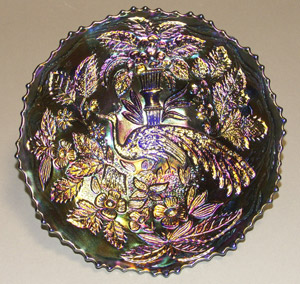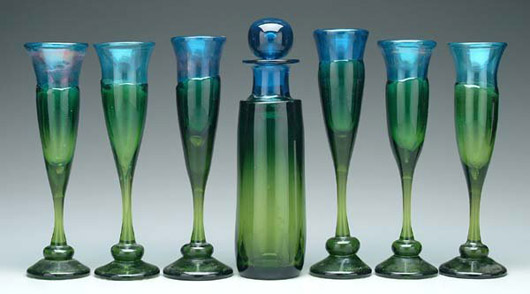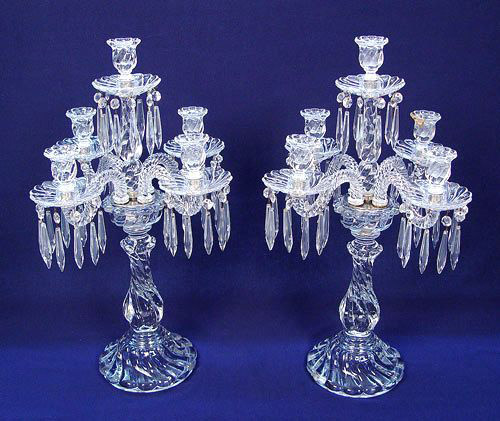
WESTON, W.Va. (AP) – Thanks mainly to West Virginia’s abundance of natural gas and silica, more than 500 glass factories have operated in the state since the early 1800s, producing everything from art glass and marbles to pop bottles and windshields.
Cheap foreign labor and skyrocketing natural gas prices, though, have left only a half-dozen commercial glass producers still up and running, and facing a future as cloudy as a sheet of smoked glass.
A museum in Weston showcases the talents of West Virginia glassmakers past and present, and offers visitors a chance to admire the wide range and beauty of glassware made here over the course of more than 150 years.
The West Virginia Museum of American Glass, founded and operated by a nonprofit association of glass enthusiasts, has converted the former J.C. Penney Building on Main Avenue into a huge display area where similar pieces made by once-competing companies can be compared and admired. Using photos, glassmaking equipment and other artifacts, the museum also tells the story of glass factories, the people who worked in them, and their impact on the communities where they were located.
“We’ve been in this location for two years now,” said Sharon Pickens, the museum’s tour guide and sole employee. “All the glass you see here has been donated, and some of the donations have come in the form of huge collections.”
While the museum showcases glassware made in other states, its focus is on West Virginia, once the heart of American glass production.
Almost every West Virginia county once had at least one glass factory, and many had several. For instance, Dunbar once had seven glass-making operations, including some that produced art glass.
“We had four big factories here in Weston – West Virginia Glass Specialties, Louie Glass Co., Colonial Glass and Masterpiece Crystal – but Masterpiece is the only one still in operation,” said Pickens. “You’d be hard-pressed to find a family in this town that didn’t have a member who worked in the glass factories.”
Still-operating factories, such as Blenko in Milton and Williamstown’s Fenton Art Glass, have displays featuring a variety of their products, as do some of the larger now-defunct manufacturers, like Fostoria in Moundsville and Seneca in Morgantown.

There is a display of colorful, decorative glass canes, made and used by union glassworkers during Labor Day parades, and a shelf bearing large “swung” vases, which glassblowers literally swung in an arc while partially molten, to give each piece a unique look.
There are numerous displays of collectors’ specialties, ranging from 1930s-vintage Depression glass to colorful, iridescent carnival glass, the type of glassware given out as prizes to winners of carnival games.
“There are collectors for everything,” said Pickens. “We had a collectors’ association that focuses on glass toothpick holders visit here last year. There are also people who collect celery vases, which people filled with cold water to keep celery crisp when they served it, and people who collect spooners, or vases used to hold teaspoons.”
The museum contains a collection of 561 glass hens, including a few made by now-defunct Kanawha Glass in Dunbar; a collection of wire-mounted hanging glass items; a display of hand-painted glassware; a display of glass-made oddities including hammers, knives and tomahawks, and a display of glass eyes.
“We’re starting to collect glass-making machinery, and we’re building a library of catalogs and other resources where collectors can research glass,” said Pickens.
The Weston museum recently acquired the collections of the American Marble Museum, formerly located in California. Display items include marbles made in West Virginia and a Roman glass marble dating to the first century.
The museum has a gift shop where visitors can start collections of their own, with items ranging from a few dollars to a few thousand dollars, or buy books, magazines and monographs about glass collecting.
The West Virginia Museum of American Glass produces a quarterly collectors’ magazine, All About Glass, which is available in the gift shop.

The museum, located at 230 Main Ave. in downtown Weston, is open on Mondays, Tuesdays, Thursdays, Fridays and Saturdays from noon to 4 p.m. Admission is free, but donations are appreciated.
___
On the Net: West Virginia Museum of American Glass: http://wvmag.bglances.com
___
Information from: The Charleston Gazette,
http://www.wvgazette.com
Copyright 2009 Associated Press. All rights reserved. This material man not be published, broadcast, rewritten, or redistributed.
AP-ES-01-31-09 1225EST
Received Id 1205405400 on Feb 01 2009 09:12


